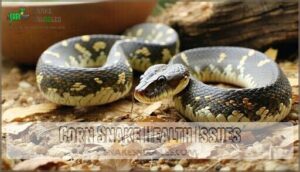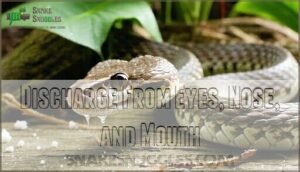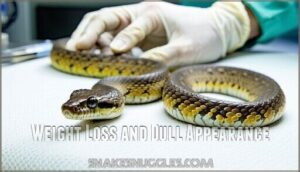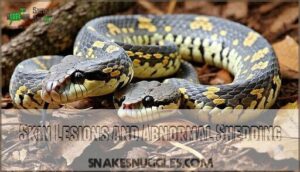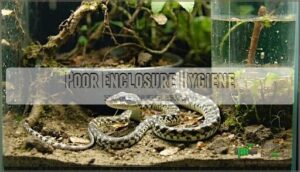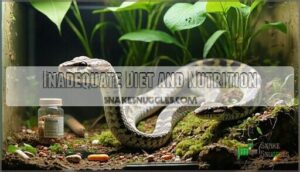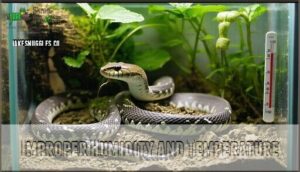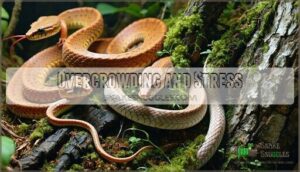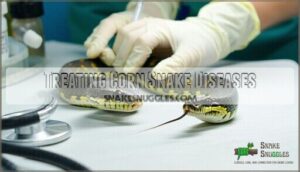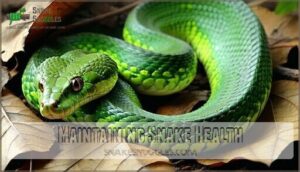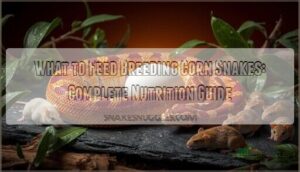This site is supported by our readers. We may earn a commission, at no cost to you, if you purchase through links.
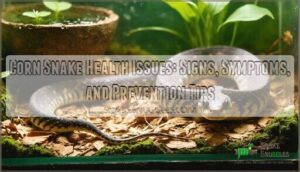 Corn snakes are generally hardy, but keeping an eye out for common health issues like scale rot, respiratory infections, and mites is key.
Corn snakes are generally hardy, but keeping an eye out for common health issues like scale rot, respiratory infections, and mites is key.
Symptoms include lethargy, loss of appetite, wheezing, or visible mites crawling on their scales. Watch for unusual shedding, open-mouth breathing, or mouth rot, which can show up as swollen gums or a cheesy discharge.
Dry, crusty skin or persistent weight loss might also signal trouble. Often, poor enclosure hygiene, improper humidity, or stress from handling too much causes these problems.
Spotting symptoms early can save your snake’s health—and maybe even its life. Proper care prevents most issues, and being aware of these potential health issues is crucial for providing the best environment for your pet, which is why keeping an eye out and spotting symptoms early are vital.
Table Of Contents
- Key Takeaways
- Corn Snake Health Issues
- Recognizing Sick Snakes
- Disease Causes and Prevention
- Treating Corn Snake Diseases
- Maintaining Snake Health
- Frequently Asked Questions (FAQs)
- Do corn snakes have health problems?
- What diseases can corn snakes get?
- What does an unhealthy snake look like?
- What are the symptoms of corn snake disease?
- How is eating corn beneficial to the body?
- How do I know if my corn snake is healthy?
- What diseases do corn snakes get?
- How do you know if a corn snake has parasites?
- What is the biggest trouble with corn snakes?
- What are the symptoms of impaction in corn snakes?
- Conclusion
Key Takeaways
- You’ll need to watch for common health issues like scale rot, respiratory infections, and mites, with symptoms including lethargy, loss of appetite, wheezing, or visible mites on scales.
- Your corn snake’s habitat directly impacts its health—maintain proper humidity levels (40-60%), temperature gradient (85°F warm side, low 70s°F cool side), and clean enclosure to prevent most diseases.
- You can spot a sick snake by observing changes in behavior, unusual discharge from eyes, nose or mouth, weight loss, dull appearance, or abnormal shedding patterns.
- You should seek veterinary care immediately if you notice emergency signs like wheezing or visible swelling, as snake diseases can escalate quickly without proper treatment.
Corn Snake Health Issues
Corn snakes can face a variety of health issues, ranging from respiratory infections to skin problems.
Recognizing these conditions early is essential for keeping your snake healthy and ensuring it lives a long, comfortable life.
Scale Rot and Skin Infections
Scale rot, a common snake skin condition, stems from bacterial infections and poor environmental factors.
Scale rot arises from bacteria and poor conditions—prompt care and ideal environments are essential to protect your corn snake’s health.
Watch for blisters or red scales on your corn snake’s belly. One potential cause is ulcerative dermatitis.
To tackle this issue:
- Keep enclosure humidity and hygiene in check.
- Treat infections promptly with antibiotics.
- Prevent recurrence by inspecting for skin injuries.
- Seek veterinary care for severe cases.
Respiratory Infections and Symptoms
Respiratory infections in corn snakes, like bacterial pneumonia or fungal infections, show symptoms such as wheezing or snake respiratory distress.
Open-mouth breathing often signals a serious issue.
Viral causes can worsen the snake respiratory tract. Poor enclosure hygiene can be a major contributing factor.
Treat promptly with veterinary care. The following symptoms and possible causes are associated with respiratory infections in corn snakes:
| Symptom | Possible Cause |
|---|---|
| Wheezing | Snake respiratory infection |
| Mouth breathing | Bacterial pneumonia |
| Gaping mouth | Viral causes |
| Nasal discharge | Fungal infections |
| Lethargy | Snake illness symptoms |
These symptoms indicate the need for immediate medical attention to prevent further complications.
Parasites and Mites
Parasites, like mites, pose serious risks to corn snake health. Mites drain blood and spread disease, while internal parasites can harm digestion and weight.
Watch for frequent soaking, irritable behavior, or visible mites.
- Mite Identification: Spot tiny black dots near the eyes or mouth.
- Preventative Care: Quarantine new snakes.
- Veterinary Exams: Detect and treat infections early.
- Treatment Options: Deep clean enclosures regularly.
Mouth Rot and Eye Infections
Mouth rot, or infectious stomatitis, often shows up as swollen gums, pus, or bloody discharge.
Eye infections might stem from poor humidity or stuck shed. Both issues can worsen fast, so clean their habitat well.
| Symptom | Possible Cause | Prevention | Treatment |
|---|---|---|---|
| Pus or Swelling | Poor Hygiene | Clean Enclosure | Antibiotic Options |
| Swollen Eyes | Eye Infection Causes | Preventing Infections | Snake Veterinary Care |
| Red Mouth | Reptile Mouth Rot | Hygienic Terrarium | Stomatitis Treatment |
| Discharge | Low Humidity or Bacteria | Monitor Humidity Levels | Immediate Vet Assistance |
The table outlines the symptoms, possible causes, prevention methods, and treatment options for common issues, emphasizing the importance of hygienic terrarium maintenance and immediate vet assistance when necessary.
Recognizing Sick Snakes
Spotting early signs of illness in your corn snake is essential for keeping it healthy and preventing serious problems.
Pay close attention to changes in behavior, appearance, and appetite, as these often signal underlying health issues, which is crucial for maintaining your snake’s overall well-being, especially when considering appetite.
Lethargy and Loss of Appetite
Sometimes, lethargy and appetite loss in corn snakes signal underlying illnesses or stress indicators.
Common causes include environmental factors like improper temperatures or humidity, as well as dietary deficiencies.
Watch for snake lethargy symptoms, such as inactivity or weight loss, and consider reptile anorexia treatment if issues persist despite changes.
If veterinary intervention is required, early action keeps your snake healthy and thriving, making it crucial to address underlying illnesses promptly.
Discharge From Eyes, Nose, and Mouth
Notice a discharge from your corn snake’s eyes, nose, or mouth? It could indicate serious reptile health problems.
Evaluate the discharge consistency and color for clues about snake disease symptoms like respiratory disease or bacterial infections.
- Eye Discharge: Cloudy or sticky? Likely an infection.
- Nasal Discharge: Bubbles suggest respiratory issues.
- Mouth Discharge: Cottage cheese-like indicates mouth rot.
- Seek Help: Visit a reptile vet promptly.
Weight Loss and Dull Appearance
If your corn snake seems unusually skinny or its body feels soft and lacks firmness, it might be experiencing muscle atrophy or nutritional deficiencies.
Watch for other snake weight loss signs like dull scales, dehydration signs, or trouble completing sheds.
Poor diet or undetected organ failure could be at play, and Parasite infections can also lead to weight loss, which is a significant health problem.
Address these corn snake health issues by consulting a reptile vet promptly.
Skin Lesions and Abnormal Shedding
Skin lesions and shedding problems often signal underlying corn snake skin issues.
Scale abnormalities, such as rough patches or blisters, could hint at infections or improper humidity.
Difficulty shedding (dysecdysis) is common with low humidity or poor hydration.
Prevent these snake skin conditions by maintaining ideal environments, and for severe cases or persistent lesions, veterinary intervention is key to ensuring your corn snake stays healthy.
Disease Causes and Prevention
In regards to keeping your corn snake healthy, understanding what causes diseases is key.
Preventing issues like infections and stress starts with proper care, including clean enclosures, balanced diets, and the right environmental conditions, which are essential for maintaining a healthy corn snake through proper care.
Poor Enclosure Hygiene
Neglecting enclosure hygiene can lead to waste buildup, bacteria growth, and mold, triggering serious corn snake diseases like bacterial or fungal infections.
Choose a substrate that’s easy to clean and replace, avoiding moisture-trapping materials.
Clean the habitat weekly, disinfecting surfaces to eliminate harmful microbes.
Consider suitable bedding options for your corn snake.
A clean environment keeps your snake healthy and prevents issues stemming from poor hygiene or unclean conditions, which is crucial for maintaining a healthy snake.
Inadequate Diet and Nutrition
A corn snake’s diet plays a huge role in its health.
Nutritional deficiencies, obesity risks, and hydration importance are key factors that affect well-being.
Make sure to:
- Rotate prey to prevent reptile vitamin deficiency.
- Offer properly sized rodents to avoid snake appetite loss or regurgitation.
- Provide fresh water daily for ideal hydration and digestion.
Improper Humidity and Temperature
Temperature and humidity aren’t just numbers on a gauge—they’re lifelines for your snake.
Poor enclosure design can cause shedding problems, skin issues, or thermoregulation troubles.
Maintain a proper humidity level (40-60%) and a temperature gradient (85°F warm side, low 70s°F cool side).
Without these, your snake faces serious reptile health issues, including problems related to humidity and temperature regulation.
Monitor snake humidity and temperature regularly.
Overcrowding and Stress
Overcrowding creates aggression triggers, weakens immunity, and shortens lifespans.
Snakes need space requirements met to avoid breeding problems and long-term stress. A cramped environment amplifies snake health issues like frequent snake symptoms or infections.
Monitor behaviors like hiding or odd activity. Avoid housing multiple snakes together unless required, ensuring each has adequate room for exercise and exploration to stay healthy.
Ensure each snake has enough space to prevent breeding problems and reduce long-term stress.
Treating Corn Snake Diseases
When your corn snake shows signs of illness, quick action is essential to guarantee recovery.
From seeking veterinary help to improving habitat conditions, effective treatment requires close attention and proper care.
Seeking Veterinary Care
If your corn snake shows emergency signs like wheezing or visible swelling, finding herpetologists is key.
Prepare for the vet visit by noting snake symptoms and recent changes.
Don’t skip post-visit care—follow all snake veterinary advice.
Snake diseases can escalate without treatment, so act quickly, as peace of mind and a healthy pet are crucial, and cost considerations matter, but snake treatment guarantees these outcomes.
Medications and Home Remedies
When a snake’s illness calls for action, snake antibiotics, antifungal treatments, or antiparasitic meds are common solutions.
For minor wounds, clean and apply reptile-safe treatments. Supplement use supports recovery.
Fluid therapy or nebulization aids hydration and breathing issues. Snake force feeding may be necessary if they won’t eat.
Always consult a vet before starting any snake disease treatment.
Hygiene and Monitoring
Good hygiene is essential for a healthy snake.
Clean the cage weekly with safe cleaners, ensuring water quality stays pristine.
Regular cleaning prevents infections and odors.
Observe shedding for abnormalities, and quarantine new arrivals to stop disease spread.
Routine fecal exams help catch parasites early.
Substrate replacement is also important for preventing disease.
Monitor snake temperature and environment consistently for ideal health—small steps prevent big problems, ensuring complete concepts of hygiene and environment are maintained.
Maintaining Snake Health
Keeping your corn snake healthy means providing the right habitat, diet, and care. By maintaining proper conditions, you can help prevent common health issues and guarantee your snake thrives.
Terrarium Setup and Decor
Your snake’s enclosure needs a thoughtful design to mimic its natural environment.
A well-designed enclosure ensures your corn snake stays happy, stress-free, and thrives in a safe, naturalistic habitat.
Include sturdy branches for climbing, varied hiding spots to reduce stress, and safe plant choices for aesthetics.
Use substrate options like cypress mulch for proper snake hygiene. Add a shallow water feature for hydration.
Specialty climbing structures can further enrich the habitat.
Regular snake cage cleaning helps maintain a healthy, comfortable snake temperature and environment.
- Hiding spots: Essential for security.
- Substrate options: Promote cleanliness.
- Climbing branches: Encourage activity.
- Water features: Keep hydration easy.
- Plant choices: Add natural charm.
Heating and Lighting Requirements
A proper snake environment needs a basking spot around 88-92°F, with a controlled UV gradient and safe night temperatures above 64°F.
Use bulb types like halogen or ceramic, paired with a thermostat control for stability.
Don’t forget reptile care basics: monitor temperatures with precision tools.
Ideal lighting boosts snake health, supporting natural rhythms essential for proper corn snake care.
Humidity and Water Requirements
Aim for a humidity level of 40-60%, increasing to 70% during shedding.
Use a water dish sized for easy access and mist the habitat every few days.
Monitor levels with a hygrometer to confirm proper corn snake care.
Hydration methods like misting and consistent humidity improve snake health, supporting shedding and environmental enrichment in their habitat.
Feeding and Nutrition Guidelines
After meeting hydration needs, focus on a balanced snake diet.
Follow these feeding guidelines:
- Offer appropriate prey size—no larger than the snake’s widest point.
- Feed juveniles weekly, adults every 1-2 weeks.
- Use frozen-thawed rodents to prevent injury.
- Avoid overfeeding; it leads to obesity.
- Supplement reptile nutrition with variety, like occasional quail eggs.
Tailor feeding to their activity level. Some owners explore alternatives, but extreme caloric restriction can be dangerous.
Frequently Asked Questions (FAQs)
Do corn snakes have health problems?
An ounce of prevention is worth a pound of cure.
Corn snakes can get illnesses like respiratory infections, mites, or stuck shed.
Watch for wheezing, dull scales, or unusual behavior, and seek a vet’s help quickly.
What diseases can corn snakes get?
Corn snakes can face diseases like respiratory infections, mouth rot, parasites (mites, ticks), and skin infections from poor habitats.
Early signs include wheezing, swelling, or abnormal behavior.
Regular care and vet visits prevent serious issues, and it is crucial for maintaining the health of corn snakes, especially in preventing respiratory problems.
What does an unhealthy snake look like?
An unhealthy snake may have dull or flaky scales, wheezing sounds, mouth breathing, or nose discharge.
Watch for lethargy, swollen areas, or visible mites.
Any sudden behavior changes or appetite loss also signal trouble.
What are the symptoms of corn snake disease?
Your corn snake may show cloudy eyes, abnormal breathing, open-mouth breathing, decreased appetite, unusual posture, skin discoloration, lumps, or discharge.
Watch for lethargy, weight loss, and difficulties shedding as potential disease indicators, including abnormal breathing.
How is eating corn beneficial to the body?
Like golden treasure in your diet, corn provides you with essential fiber, vitamins B and C, and antioxidants.
You’ll boost digestive health, strengthen your immune system, and gain energy while supporting eye health, with essential benefits from consuming corn.
How do I know if my corn snake is healthy?
A healthy corn snake has clear eyes, smooth scales, regular breathing, and a clean mouth with no discharge.
You’ll notice active movement, proper shedding, and normal eating habits when your pet’s thriving.
What diseases do corn snakes get?
Your corn snake may contract respiratory infections, infectious stomatitis (mouth rot), parasites, skin infections (dermatitis), or septicemia.
Watch for symptoms like wheezing, mouth discharge, abnormal shedding, lethargy, and changes in eating habits, which can indicate serious conditions such as septicemia.
How do you know if a corn snake has parasites?
Look for weight loss despite regular feeding, regurgitation, and unusual feces.
You’ll notice visible worms in stool, lethargy, reduced appetite, or a dull appearance.
Regular fecal exams by a reptile vet confirm parasitic infections.
Regular feeding and the presence of visible worms are critical signs to monitor.
What is the biggest trouble with corn snakes?
The biggest challenge with corn snakes is maintaining proper temperature and humidity levels.
You’ll need to monitor these carefully, as improper environmental conditions can lead to respiratory infections, difficult shedding, and stress-related illnesses.
What are the symptoms of impaction in corn snakes?
Your snake’s silent cry for help reveals itself through constipation, swollen belly, lethargy, lack of appetite, and regurgitation.
You’ll notice reduced or no bowel movements and visible discomfort when handling your corn snake, which can be a sign of a serious issue related to regurgitation.
Conclusion
Proactive prevention proves paramount in protecting your pet from corn snake health issues and symptoms.
By maintaining proper humidity, temperature, and cleanliness in your snake’s habitat, you’ll substantially reduce health risks.
Regular observation lets you catch potential problems before they become serious.
Remember, your corn snake depends entirely on you for its wellbeing, and with consistent care and quick response to any concerning signs, you’ll enjoy many healthy years with your scaly companion.
- https://image.petmd.com/files/2024-12/1730300-24-10-PMD-CornSnakeCareSheet.pdf?VersionId=C85M2VWn84MucQ1nerMeMYFQ3gfu0JZS?utm_source=petmd.com&utm_campaign=caresheet&utm_medium=PDF
- https://www.wildlifedemonstrations.com/post/scale-rot-how-to-identify-and-treat
- https://www.petco.com/content/content-hub/home/articlePages/health-wellness/reptile-scale-rot.html
- https://vcahospitals.com/know-your-pet/snakes-diseases
- https://lbah.com/reptile/snake-skin-conditions/

